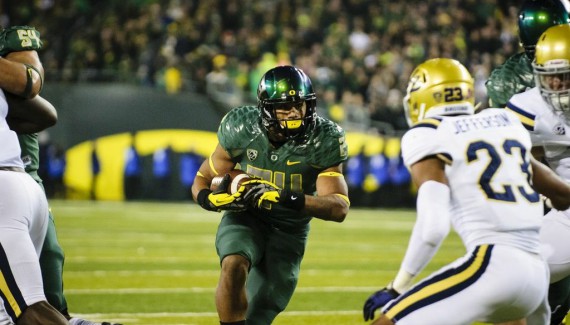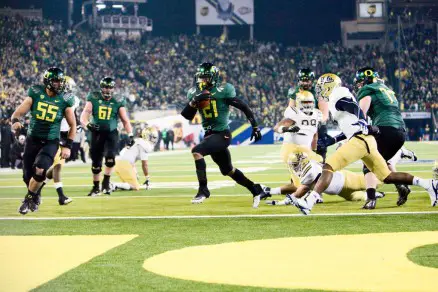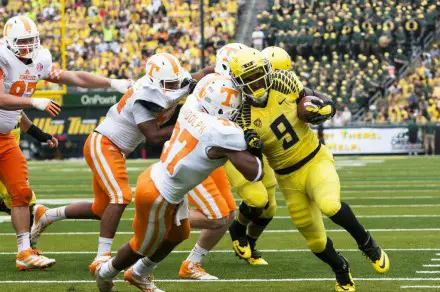Over the past decade, Oregon’s rushing attack has set the standard in college football.
This has been particularly evident since the arrival of Chip Kelly as offensive coordinator in 2007, as the Ducks have finished in the Top-10 nationally in rushing during each of the past seven seasons, a truly remarkable feat.
Dating all the way back to the early 2000’s with runners such as Maurice Morris and Onterrio Smith, through the electrifying and record-setting performances of LaMichael James and Kenjon Barner over the past few years, Oregon has found a way to move the ball on the ground more effectively than any other team.
One of the main reasons for this rushing dominance is the depth that the Ducks have been able to find at running back. Not only does Oregon seem to always have at least two great backs, but it also has minimal, if any, lag time between elite runners.
There just always seems to be an excessive amount of talent waiting in the wings in Eugene. In 2007, Jonathan Stewart dominated his competition and became a first-round pick in the NFL draft. In 2008, LeGarrette Blount, a future thousand-yard rusher in the NFL, and Jeremiah Johnson took over.
The era of the smaller backs began in 2009 with LaMichael James and Kenjon Barner, who now sit at No. 1 and No. 2 respectively on the school’s all-time rushing list.
The running backs are not the only position that deserves credit for this rushing prowess, though. While the offensive line has certainly earned as much praise as anyone, the Ducks have produced their fair share of mobile quarterbacks as well, ranging from the straight-line speed of Dennis Dixon to the startling power of Jeremiah Masoli.
Heading into 2014, Oregon’s backfield looks as strong as ever with junior Byron Marshall, sophomore Thomas Tyner, and the intriguing 5-star recruit Royce Freeman. And, while these three will likely get the bulk of the carries, behind them are other promising players providing valuable depth such as Ayele Forde, Kenny Bassett, redshirt freshman Kani Benoit and another highly-touted incoming freshman Tony James.
Also, let us not forget about Marcus Mariota at quarterback who had 715 yards and nine touchdowns (7.45 yards per carry) in 2013. It is incredible to think about what he could have done had he been completely healthy for the whole 2013 season.
However, it is not just the names that impress so much about this particular backfield. Equally encouraging are the exceptional physical traits.
From 2009 through 2011, James was nearly automatic in short-yardage situations. Though undersized, his low center of gravity and remarkable leg strength made him absolutely lethal, and he was virtually unstoppable on short third downs and goal line situations.
Before him, Stewart and Blount were both well over 220 pounds, supplying plenty of power themselves.
However, in 2013 Oregon seemed to be missing this short-yardage power element. This is not to take away from Marshall, Tyner, and De’Anthony Thomas, who still provided the Ducks with an exceptional rushing attack. There just seemed to be a missing piece.
Oregon’s red zone touchdown percentage was down to 66 percent from 80 percent in 2012 and 76 percent in 2011. Much of this was due to a lack of bulk or power out of the backfield.
Now, with another year under their belts, Marshall and Tyner have filled out their frames a bit more. Marshall has eclipsed the 200-pound mark while Tyner will likely be pushing 220 or 225 pounds by the start of 2014.
And then there is Freeman, who joins the Ducks at a much-needed weight of 227 pounds, providing an immediate power source out of the Oregon backfield. Not only does he have great size, but Freeman demonstrated incredible balance in high school, showing an uncanny knack to stay on his feet.
One of the most encouraging facts about this personnel group is that this size does not come at the cost of speed. On the contrary, Tyner is one of the fastest sprinters in Oregon history, and Marshall and Freeman have demonstrated an ability to leave defenders in the dust.
For the first time that most Duck fans will be able to remember, Oregon has three backs that will not be plagued by specialized labels. Sure, their skill sets vary in certain categories, but all three of these runners have the rare blend of speed and size to be considered “balanced,” as opposed to a smaller speed back like Barner or a larger power back like Blount.
Marshall, Tyner, and Freeman all eclipse 200 pounds. They all have speed to keep defenses up at night, and will be called upon at any point in the game to maintain fresh legs out of the backfield. When factoring in the contributions of Forde, Bassett, and James, that makes Oregon’s rushing attack extremely dangerous, and could even turn it into the best in school history. This is a claim that largely feels even more realistic after factoring in the wheels of Mariota, and the return of stud linemen Hroniss Grassu, Tyler Johnstone, and Jake Fisher.
They may be young, but Marshall, Tyner, and Freeman should make plenty of noise in 2014 and carry on Oregon’s tradition of dominating on the ground. Based on their phenomenal, balanced, physical skill sets, it is not unrealistic to think that in a few years college football fans will look back and see them as one of the best running back corps in recent memory.
Top Photo by Craig Strobeck
Related Articles:
Joey Holland graduated from the University of Oregon in 2013, majoring in History. He played several sports in high school, though football remains his passion. He has yet to miss a single Oregon Ducks home football game during his time in Eugene. Joey has written previously for Bleacher Report and Football Nation.
Joey welcomes your feedback.



